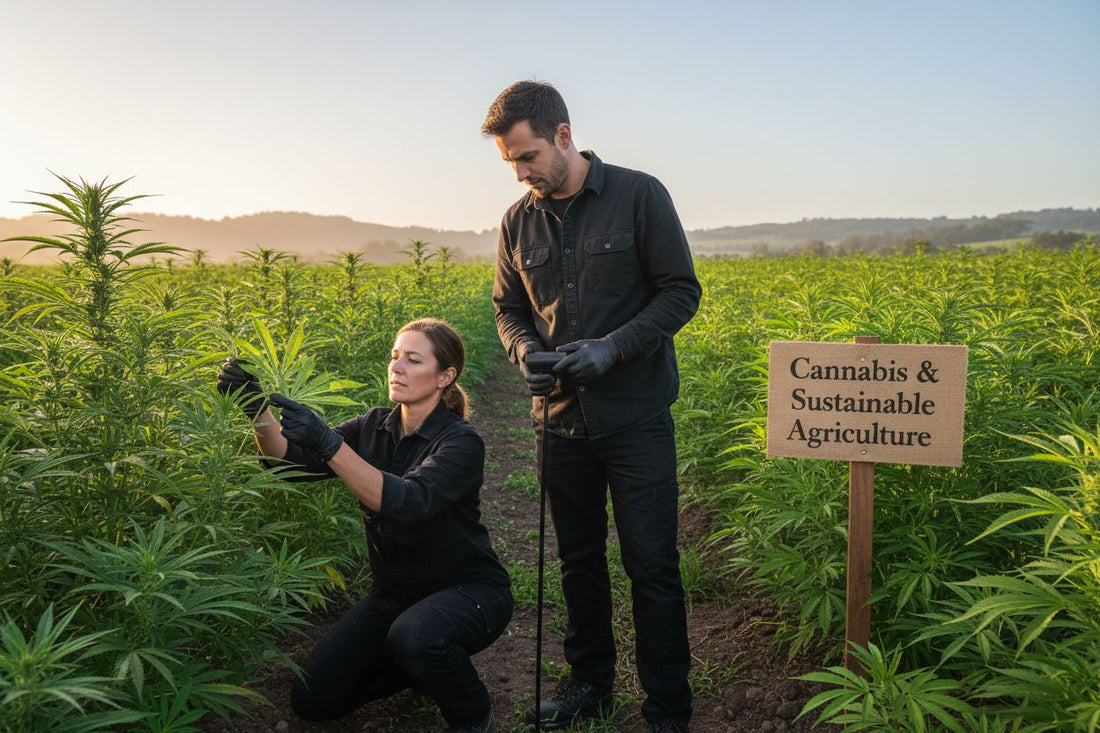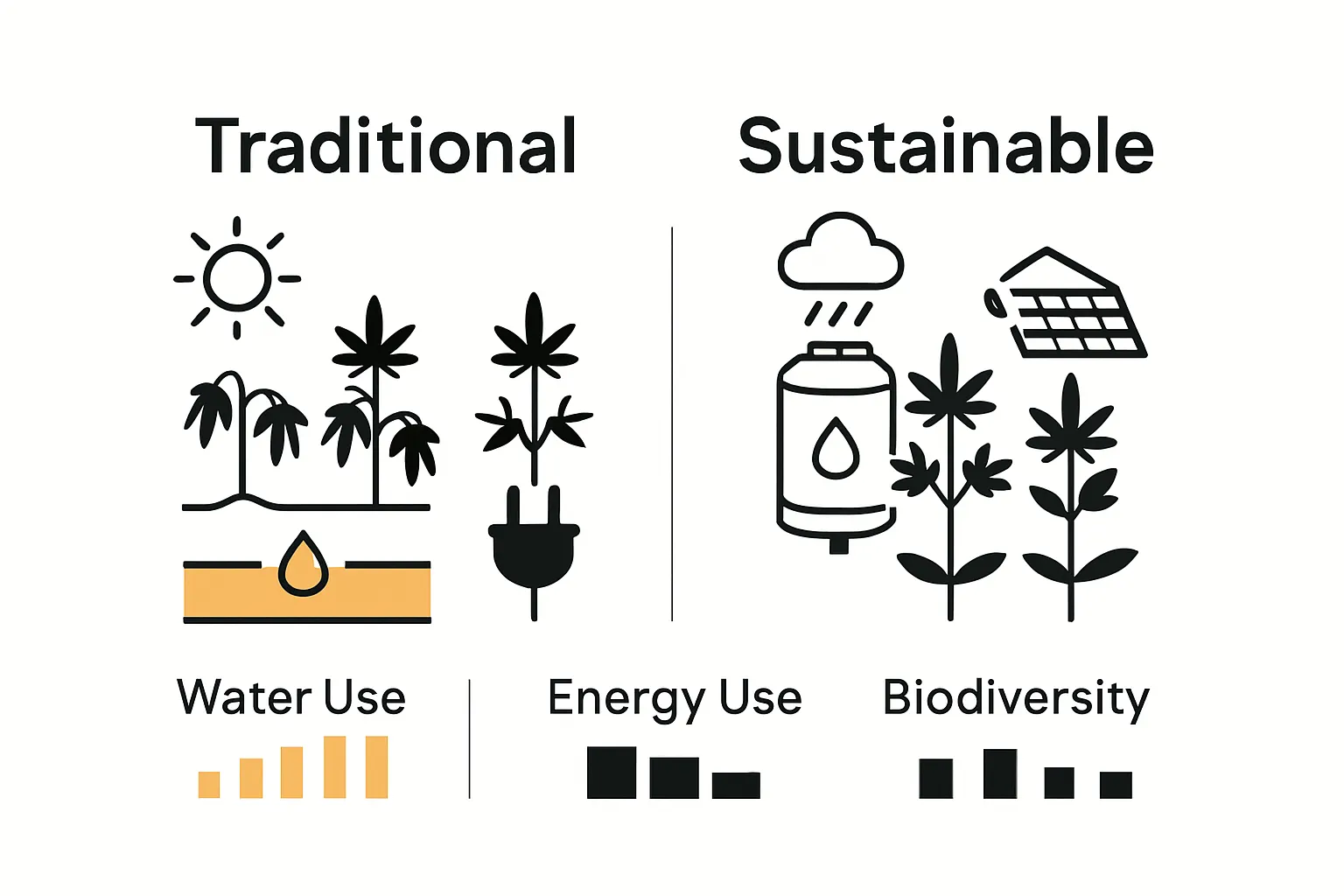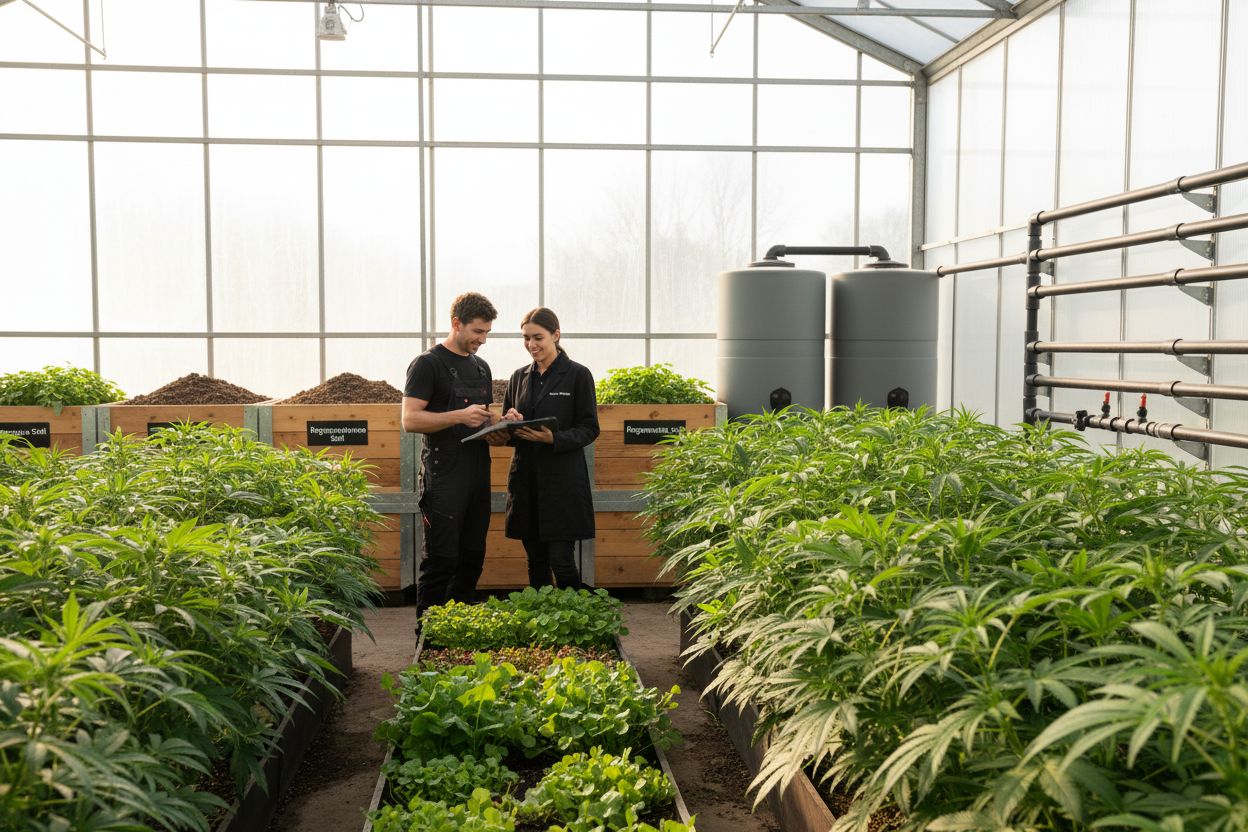Understanding Cannabis and Sustainable Agriculture Practices
Written by Trevor

Cannabis farming is moving far beyond just harvesting a plant. Growing cannabis now uses almost as much energy as some small industries and traditional indoor grows can require up to 2,000 watts of electricity per square meter. You might assume this makes clean, responsible farming impossible. Turns out, the biggest breakthroughs are not just in the plant itself but in new sustainable techniques that help farmers cut costs, save water, and protect whole ecosystems all at once.
Table of Contents
- What Is Cannabis And Sustainable Agriculture?
- Why Sustainable Practices Matter In Cannabis Cultivation
- How Cannabis Cultivation Affects Ecosystems
- Key Principles Of Sustainable Agriculture In Cannabis
- Real-World Applications Of Sustainable Cannabis Farming
Quick Summary
| Takeaway | Explanation |
|---|---|
| Implement regenerative soil practices | Focus on rebuilding soil health through organic methods like composting and cover cropping. |
| Adopt water-efficient irrigation methods | Utilize techniques like precision irrigation and rainwater harvesting to conserve water. |
| Integrate renewable energy sources | Reduce carbon emissions by using solar or wind energy for cultivation processes. |
| Enhance biodiversity in farming | Promote local ecosystems by planting companion crops and preserving natural habitats. |
| Minimize chemical inputs | Use organic pest management to lower ecological impact and protect natural resources. |
What is Cannabis and Sustainable Agriculture?
Sustainable agriculture represents a holistic approach to cultivating crops that prioritizes environmental health, economic viability, and social responsibility. When applied to cannabis cultivation, this approach transforms traditional farming practices into a comprehensive ecosystem management strategy.
Defining Sustainable Cannabis Agriculture
Sustainable cannabis agriculture goes beyond simply growing a plant. It encompasses a complex system of cultivation practices that minimize environmental impact while maximizing crop health and productivity. According to the Food and Agriculture Organization, sustainable agriculture aims to meet current agricultural needs without compromising future generations’ ability to produce food and resources.
In the context of cannabis, sustainable practices include:
- Soil conservation and regenerative techniques
- Water-efficient irrigation methods
- Organic pest management strategies
- Reducing carbon footprint through renewable energy
- Preserving biodiversity in cultivation areas
Environmental and Economic Benefits
Cannabis sustainable agriculture offers significant advantages for both ecological systems and farmers. By implementing regenerative practices, cultivators can improve soil health, reduce chemical inputs, and create more resilient cultivation environments. Read more about sustainable cannabis cultivation practices to understand the intricate balance between agricultural productivity and environmental stewardship.
These practices not only protect natural ecosystems but also create more stable, long-term economic models for farmers. Sustainable agriculture reduces input costs, improves crop quality, and creates a more predictable cultivation environment.
Below is a table comparing traditional cannabis cultivation methods and sustainable cannabis agriculture practices, highlighting their environmental and economic impact for clearer understanding.
| Aspect | Traditional Cannabis Cultivation | Sustainable Cannabis Agriculture |
|---|---|---|
| Water Consumption | High; risk of water depletion | Reduced through efficient irrigation |
| Electricity Use | Substantial, especially for indoor grows | Lowered via renewable energy integration |
| Chemical Inputs | Frequent use of fertilizers and pesticides | Minimized; favors organic management |
| Soil Health | Often leads to degradation | Focus on regenerative soil management |
| Biodiversity Impact | Can disrupt local habitats | Enhances biodiversity and ecosystem health |
| Long-Term Economic Viability | High inputs may increase costs over time | Reduces inputs, favors economic resilience |
| Carbon Footprint | High due to reliance on fossil fuels | Lowered with solar/wind energy adoption |
Why Sustainable Practices Matter in Cannabis Cultivation
Cannabis cultivation represents a complex agricultural endeavor with substantial environmental implications. Research from environmental science publications reveals that traditional cannabis farming can generate significant ecological challenges, making sustainable practices critically important for the industry’s future.
Environmental Impact and Resource Consumption
Traditional cannabis cultivation often requires extensive resources that can strain natural ecosystems. The farming process typically demands high water consumption, substantial electricity for indoor growing, and significant land use. These factors contribute to carbon emissions, water depletion, and potential habitat disruption.
Key environmental challenges include:

- High water requirements for crop irrigation
- Substantial electricity consumption for climate control
- Chemical fertilizer and pesticide usage
- Land transformation and potential deforestation
- Energy-intensive indoor growing techniques
Economic and Ecological Resilience
Sustainable cannabis agriculture offers a comprehensive solution to these environmental challenges. Learn more about sustainable cultivation methods to understand how regenerative practices create long-term value.
By implementing eco-friendly cultivation techniques, farmers can simultaneously address environmental concerns and create more economically stable agricultural systems. Sustainable practices reduce operational costs, minimize ecological damage, and create more resilient crop production models. These approaches include organic farming methods, renewable energy integration, water conservation strategies, and natural pest management techniques that work in harmony with local ecosystems.
This table summarizes the key environmental challenges associated with cannabis cultivation and the sustainable practices used to mitigate them.
| Environmental Challenge | Impact on Ecosystem | Sustainable Solution |
|---|---|---|
| High Water Requirements | Strains local water resources, affects watersheds | Precision irrigation, rainwater harvesting |
| High Electricity Consumption | Increases carbon emissions, energy costs | Use of solar/wind power, LED lighting |
| Chemical Fertilizer Use | Runoff into soil and waterways, ecosystem imbalance | Composting, organic soil amendments |
| Pesticide Usage | Harms beneficial insects, disrupts ecosystems | Organic pest management, companion planting |
| Land Transformation | Habitat loss, loss of plant/insect biodiversity | Maintaining wildlife corridors, minimal disturbance |
| Indoor Growing Techniques | Energy intensive, significant resource consumption | Passive greenhouse design, renewable energy sources |
Moreover, sustainable cannabis cultivation represents a forward-thinking approach that aligns agricultural productivity with environmental stewardship. By prioritizing ecological balance, farmers can produce high-quality cannabis while preserving natural resources and supporting broader environmental conservation efforts.
How Cannabis Cultivation Affects Ecosystems
Cannabis cultivation represents a complex agricultural practice with profound and multifaceted ecological interactions. According to environmental research studies, the impact of cannabis farming extends far beyond simple crop production, influencing soil health, water systems, and local biodiversity.
Soil and Land Ecosystem Dynamics
Traditional cannabis cultivation can significantly alter terrestrial ecosystems through various mechanisms. Intensive farming practices often lead to soil degradation, nutrient depletion, and potential erosion. The cultivation process can disrupt natural soil microbiomes, potentially reducing long-term land fertility and ecological resilience.
Key ecosystem interactions include:
- Alteration of native soil microbial communities
- Potential disruption of local plant and insect biodiversity
- Changes in soil structure and nutrient composition
- Impact on surrounding vegetation and wildlife habitats
- Potential introduction of non-native species
Water Systems and Ecological Balance
Cannabis cultivation has substantial implications for regional water ecosystems. High water consumption and potential chemical runoff can dramatically affect local watersheds, stream ecosystems, and groundwater systems. Explore the intricate details of cannabis cultivation in California’s unique agricultural landscape to understand these complex ecological interactions.
Water-related ecological challenges include potential contamination from agricultural chemicals, disruption of natural water flow patterns, and increased pressure on local water resources. Sustainable cultivation practices can mitigate these impacts by implementing water-efficient irrigation techniques, reducing chemical inputs, and protecting natural watershed integrity.
Understanding these ecological interactions is crucial for developing responsible cannabis cultivation strategies that balance agricultural productivity with environmental preservation. By recognizing the complex relationships between cannabis farming and ecosystem health, cultivators can develop more harmonious and sustainable agricultural practices.
Key Principles of Sustainable Agriculture in Cannabis
Scientific research on agricultural sustainability reveals that successful cannabis cultivation requires a holistic approach that balances ecological integrity with agricultural productivity. Sustainable agriculture in cannabis is not merely a set of techniques but a comprehensive philosophy of environmental stewardship and responsible farming.
Regenerative Soil Management
Regenerative soil practices form the foundation of sustainable cannabis agriculture. This approach focuses on rebuilding and maintaining soil health through organic methods that enhance natural ecosystem functions. By prioritizing soil microbiome diversity, farmers can create resilient growing environments that reduce dependency on synthetic inputs and promote long-term land fertility.
Key regenerative soil principles include:

- Minimal soil disturbance
- Cover cropping and crop rotation
- Organic matter integration
- Composting and natural nutrient cycling
- Promoting beneficial microbial communities
Water and Resource Conservation
Learn more about premium cannabis sourcing practices that demonstrate sustainable cultivation techniques. Water management represents a critical component of sustainable cannabis agriculture, requiring innovative strategies to minimize consumption and prevent ecological disruption.
Effective water conservation strategies involve precision irrigation techniques, rainwater harvesting, closed-loop water recycling systems, and selecting drought-resistant cannabis cultivars. These approaches not only reduce environmental impact but also create more economically resilient agricultural models that can withstand changing climate conditions.
By implementing these comprehensive principles, cannabis farmers can transform agricultural practices from extractive models to regenerative systems that support ecological health, biodiversity, and long-term sustainability. The goal is to create a holistic approach that views cannabis cultivation as an integrated ecosystem rather than a simple commodity production process.
Real-World Applications of Sustainable Cannabis Farming
Agricultural research at UC Davis demonstrates that sustainable cannabis farming is more than a theoretical concept, representing a practical approach to revolutionizing agricultural practices. By implementing innovative techniques, farmers are transforming cannabis cultivation into an environmentally responsible and economically viable industry.
Energy and Resource Efficiency
Sustainable cannabis farming prioritizes reducing energy consumption and minimizing environmental footprints. Modern cultivation techniques focus on developing sophisticated systems that dramatically decrease resource utilization while maintaining high crop quality. Advanced greenhouse technologies, solar-powered irrigation systems, and intelligent climate control mechanisms enable farmers to optimize energy expenditure and reduce carbon emissions.
Key energy efficiency strategies include:
- Implementing LED grow lights with lower electricity consumption
- Using renewable energy sources like solar and wind
- Developing passive solar greenhouse designs
- Utilizing smart sensor technologies for precise resource management
- Designing closed-loop water and nutrient recycling systems
Biodiversity and Ecosystem Integration
Explore different cannabis cultivation methods to understand how farmers are creating more harmonious agricultural ecosystems. Sustainable cannabis farming goes beyond traditional cultivation by actively supporting local biodiversity and ecosystem health.
Farmers are increasingly adopting practices that integrate cannabis cultivation with natural landscape characteristics. This approach involves planting companion crops, maintaining wildlife corridors, preserving natural predator habitats, and using organic pest management techniques that support broader ecological systems. By treating cannabis cultivation as part of a complex, interconnected ecosystem, farmers can create agricultural environments that contribute positively to local biodiversity and environmental resilience.
Choose a Cannabis Experience That Protects Our Planet
Looking for wellness solutions that also honor the earth? The article highlighted how traditional cannabis cultivation can strain soil, waste precious water, and damage ecosystems. At California Blendz, we take the pain out of these concerns by carefully sourcing every product from farms that keep soil healthy, use water smartly, and put nature first. When you explore our CBD Sun Grown collection, you are choosing CBD flowers grown under the California sun with regenerative, organic methods. Each product comes with clear lab results and transparent sourcing, so you never have to worry about needless chemicals or hidden shortcuts.

Join the movement for sustainable cannabis and treat yourself responsibly today. Start finding your ideal experience at California Blendz or discover premium quality flowers in our Founder’s Collection that put environmental care at the forefront. Shop now and support a future where cannabis and nature thrive together.
Frequently Asked Questions
What are the key principles of sustainable cannabis agriculture?
Sustainable cannabis agriculture focuses on regenerative soil management, water and resource conservation, organic pest management, and reducing the carbon footprint through renewable energy. These principles aim to enhance ecological balance while ensuring agricultural productivity.
How does traditional cannabis cultivation impact the environment?
Traditional cannabis cultivation can lead to high water consumption, substantial electricity use, chemical runoff, and habitat disruption. These practices may contribute to ecological degradation and strain on natural resources.
What are the benefits of sustainable cannabis farming for farmers?
Sustainable cannabis farming helps improve soil health, reduces input costs, and creates a more predictable cultivation environment. It also supports long-term economic stability through enhanced crop quality and resilience against climate variability.
How can cannabis farmers conserve water effectively?
Cannabis farmers can conserve water by implementing precision irrigation techniques, utilizing rainwater harvesting, adopting closed-loop recycling systems, and choosing drought-resistant cultivars. These practices minimize water usage while maintaining crop health.
Recommended
- The Environmental Impact of CBD Flower Farming: Understanding the Sust – California Blendz
- Cannabis Wellness Without the High: Navigating the Safe & Sober Path – California Blendz
- Understanding How Cannabis is Cultivated: A Deep Dive – California Blendz
- Cultivation Methods: Outdoor vs Greenhouse vs Indoor Hemp Flower. Whic – California Blendz








